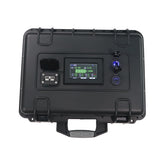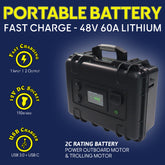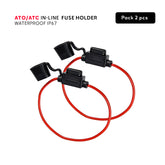Guide to Overcurrent Protection Devices for Boats: Types & Installation
Marine Guide : Overcurrent Protection for Boats
Boating is one of the most rewarding experiences, but it comes with responsibilities—especially when it comes to electrical safety. Every system on your boat, from essential navigation tools to comfort equipment, depends on a reliable electrical setup. The marine environment, however, is unforgiving. Saltwater, constant vibrations, and extreme weather can easily compromise your boat’s electrical integrity.
Why Overcurrent Protection Matters
This is where overcurrent protection devices (OCPs) come into play. These small but essential components, including fuses and circuit breakers, prevent electrical faults from escalating into serious problems. Without them, a simple overload or short circuit could lead to overheating, system failures, or even a fire that can escalate very quickly. What starts as a small electrical issue could ruin your weekend, result in a total loss of your boat, or even necessitate an intervention by the SNSM or coast guard—something every boater hopes to avoid.
How This Guide Will Help
This guide is designed to give you a clear understanding of how these devices work, how to select the right ones for your boat, and how to install and maintain them effectively. With the right knowledge and tools, you can take charge of your boat’s electrical system, ensuring it remains safe and reliable in every condition.

Understanding Overcurrent Protection Devices (OCPs)
Overcurrent protection devices (OCPs) are vital for safeguarding your boat’s electronics. While their role in protecting human safety is crucial, their primary purpose on a boat is to ensure the longevity and security of your electronic systems. From navigation equipment to critical engine controls, these devices are designed to prevent costly damage caused by electrical faults.
Protecting Your Electronics and Your Boat
Marine electronics are significant investments. A single short circuit or overload can result in the failure of expensive devices like GPS systems, autopilots, or communication radios. Most modern electronics come with built-in fuses, but these aren’t always marine-grade, and they may not provide sufficient protection for your boat setup.
Additional Fuses for Extra Protection
There are also situations where additional fuses are necessary. For example, when installing equipment behind a battery, a bus bar, or in an electrical distribution box, you’ll often need to add extra protection. This ensures that individual circuits are safeguarded, even if the main fuse or breaker is in place.
Compliance with Manufacturer Standards
Proper fusing isn’t just about protection—it’s also about compliance. Many electronics manufacturers require a detailed wiring diagram before honoring a warranty return. If your system lacks appropriate fusing or circuit protection, you might find yourself covering the cost of repairs or replacements out of pocket.
Types of Overcurrent Protection Devices
Understanding the different types of overcurrent protection devices (OCPs) is essential when setting up or upgrading your boat’s electrical system. Each type offers unique features and serves specific roles in safeguarding your electronics and ensuring their longevity.
Fuses: Reliable and Simple Protection
Fuses are among the simplest and most reliable forms of protection. They blow or melt when the current exceeds a predetermined limit, effectively stopping the flow of electricity and preventing further damage. Depending on the application, different fuse types are available, each with distinct features:
-

ATO/ATC Fuses: Compact and Practical
ATO/ATC fuses are compact blade-style fuses commonly used for low-current applications such as radios, navigation lights, and small pumps. Their simplicity and color-coded design make them easy to replace and identify. However, not all ATO/ATC fuses are marine-grade, so it’s often worth upgrading to corrosion-resistant versions designed for the marine environment. -

ANL Fuses: High-Demand Protection
ANL fuses are the powerhouse of marine electrical protection, capable of handling currents from 80A to 400A. These are ideal for high-demand systems like inverters, air conditioning units, and bow thrusters. ANL fuses are widely available worldwide, making them a convenient choice for sailors who need replacements in remote locations. They are robust, reliable, and suited for critical circuits where large current flows are expected. -

Fuses with Studs: Compact and Durable
Fuses with studs are particularly useful for harness protection or isolating individual devices directly linked to the battery, such as bilge pumps or power sockets. Their compact, durable design makes them ideal for installations in tight spaces or where independent circuit protection is required. Choose an automatic version behind a circuit breaker, and you will never touch it again.
Circuit Breakers: Reusable and Versatile Protection
Circuit breakers, unlike fuses, offer reusable protection by tripping during a fault and allowing for a reset. They come in several varieties, each suited for specific situations:
Types of Circuit Breakers
-

Thermal Breakers: These breakers trip when excessive heat is generated by an overcurrent. They are well-suited for applications with temporary surges, such as powerful bilge pumps or HVAC systems, where occasional overloads are expected.
-
Magnetic Breakers: These breakers respond almost instantly to sudden current spikes, providing rapid protection against short circuits. They are ideal for critical systems where immediate action is necessary to prevent equipment damage.
Solid-State Breakers: These advanced circuit breakers use electronic components to detect and interrupt overcurrent. They offer precise protection, faster response times, and greater reliability, especially in systems with sensitive electronics. Additionally, solid-state breakers operate silently and withstand repeated tripping without mechanical wear.
Choosing between these options depends on your system's specific needs and the balance you want between protection, convenience, and reliability. Each type of OCP plays a vital role in maintaining the security of your boat’s electrical system, ensuring your devices operate smoothly and efficiently.
Manual Reset or Auto Reset?
When selecting overcurrent protection devices (OCPs) for your boat, it's essential to consider the reset functionality of fuses and circuit breakers, as this choice impacts both safety and convenience. OCPs are available with either manual or automatic reset mechanisms, each offering distinct advantages tailored to specific applications.

Manual Reset Devices
Manual reset devices require a physical action to restore power after a fault has been addressed. This ensures that any issues are thoroughly investigated before re-energizing the circuit, making them ideal for critical systems where safety is paramount. For instance, in marine environments, manual reset fuses and circuit breakers are commonly used in essential circuits to prevent unintended power restoration, which could lead to further damage or hazards. Their robust design enhances reliability, and the need for manual intervention ensures that faults are properly diagnosed and rectified before the system is back online.
Automatic Reset Devices
Automatic reset devices automatically restore power once the fault condition clears, offering convenience in non-critical circuits where immediate recovery is beneficial. In marine applications, auto-reset fuses and circuit breakers are advantageous for systems like bilge pumps or auxiliary lighting, where temporary faults may occur, and continuous operation is desired. However, it's important to note that while auto-reset devices minimize downtime, they may repeatedly cycle in the presence of persistent faults, potentially leading to further issues if not monitored properly.
Choosing the Right Reset Mechanism
The decision between manual and automatic reset OCPs should be based on the criticality of the circuit and the specific needs of your boat's electrical system. For vital systems where safety and thorough fault investigation are crucial, manual reset devices are preferable. Conversely, for non-essential circuits where convenience and continuous operation are prioritized, automatic reset devices may be more appropriate.

By understanding the features and applications of different fuses and circuit breakers, and carefully selecting the appropriate reset mechanism, you can ensure that your boat's electrical system remains robust, reliable, and tailored to your specific requirements.
Selecting the Appropriate Overcurrent Protection Device (OCP)
Choosing the right overcurrent protection device (OCP) for your boat’s electrical system involves careful consideration of several key factors. Each decision, from the type of OCP to its size and placement, affects the overall efficiency, safety, and organization of your setup.
Factors to Consider
- Current Rating (C-Rating): One of the most critical aspects of selecting an OCP is ensuring its current rating matches the electrical load of the circuit it protects. An undersized OCP will trip frequently, causing unnecessary interruptions, while an oversized one may fail to protect the system during a fault, leading to potential damage. Knowing the expected current draw of your equipment is essential.
- Voltage Rating: Each OCP is designed to operate within a specific voltage range. Ensuring compatibility with your boat’s electrical system—whether it’s 12V, 24V, or higher—is crucial to maintaining system integrity and safety. Selecting an OCP with the correct voltage rating prevents it from being overstressed or failing prematurely.
- Environment: In marine conditions, certain areas of a boat are more exposed to environmental stressors such as constant humidity, salt, and vibrations. Some fuse holders are specifically designed to offer higher levels of waterproof protection. Those with superior IP ratings—typically starting at IP67—are sufficient for most common applications. For areas with constant water exposure, IP68 or IP69K-rated holders are recommended. Selecting the right fuse holder and pairing it with tin-plated wire can significantly enhance the durability and reliability of your installation.
Sizing Guidelines
Selecting the right size for your fuses and circuit breakers depends on a combination of wire gauge, load requirements, and environmental factors. Here's a general approach to help guide your decision-making process:

- Determine the wire gauge and maximum current capacity: The wire size in your system dictates the maximum safe current it can carry. Refer to a marine wire gauge chart to ensure your wiring is adequate for the circuit’s load. To simplify this step, you can use Baywatt’s Wire Section Calculator and Converter, which helps determine the appropriate wire section based on your system’s requirements.
- Calculate the load requirements: Add up the current draw of all devices on the circuit. For continuous loads, like lighting or navigation systems, it’s recommended to use an OCP rated at 125% of the total load to allow for a safety margin.
- Account for ambient temperature and derating factors: Heat and other environmental factors can impact an OCP’s performance. Choose a device that can handle the operational conditions of your boat, including any additional heat generated in confined spaces.
Tailoring Your OCP Setup
Your choice of OCP also depends on how you plan to organize and protect your circuits. Each type of fuse and breaker has unique features that cater to different setups.
| Fuse Type | Pros | Cons |
|---|---|---|
| ATO/ATC Fuse Holders | • Ideal for small and medium boats • Can organize multiple circuits (6-way/12-way holders) • Some models have Negative bus bar to simplify wiring • Waterproof single inline holders available |
• Limited to low to medium current applications (30A max per position) • May require additional protection in extremely exposed areas |
| ANL Fuses | • Excellent for high-current applications • Worldwide availability • Robust and durable design • Suitable for critical circuits |
• Requires more space • Needs heavy-duty holders • Not as compact as other fuses |
| Fuses with Studs | • Does not require separate holders (plug-and-play) • Compact design saves space • Ideal for harness installations or protecting bilge pumps |
• Limited to specific circuit types • May not suit very high current systems |
| Thermal Circuit Breakers | • Resettable solution for large circuits • Accommodates thicker cables (larger studs: M5, M8, M10) • LED indicators simplify troubleshooting |
• Larger size may not fit all setups • Higher initial cost compared to traditional fuses |
Installation Best Practices
Proper installation of overcurrent protection devices (OCPs) is essential to ensure the safety and efficiency of your boat’s electrical system. Following best practices not only protects your equipment but also makes future troubleshooting and maintenance easier.
Placement: Protecting Circuits Effectively

The placement of OCPs plays a vital role in safeguarding your electrical system. Here are key guidelines to follow:
- As close as possible to the power source: OCPs should be installed as close as possible to the power source, such as the battery or distribution panel. This minimizes the length of unprotected wiring, reducing the risk of damage in case of a fault.
- Protect branch circuits individually: Each circuit on your boat should have its own dedicated fuse or breaker. This ensures that a fault in one circuit doesn’t compromise the entire system.
- Consider accessibility: Place OCPs in locations that are easy to access for inspections, replacements, or resets. This is particularly important for manual reset breakers, which require user intervention.
- Protect exposed areas: For circuits in wet or exposed areas, use waterproof inline holders to protect the fuses. This helps prevent corrosion and ensures reliable operation even in harsh conditions.
Maintenance & Inspection
Regular maintenance and inspection of overcurrent protection devices (OCPs) are essential to ensure the safety and efficiency of your boat’s electrical system. Neglecting this can lead to unexpected failures, costly repairs, or even damage to your electronics. Here’s how to stay ahead of potential issues.

Routine checks: Keep your system in top condition: Regular inspections are the first line of defense against electrical failures. By identifying and addressing minor issues early, you can avoid larger problems down the line.
- Visual inspection: Periodically check all fuses and circuit breakers for signs of wear, corrosion, or physical damage. Look for discoloration, cracks, or melted components, which can indicate overheating or overuse.
- Check connectors: Ensure that all connectors are tight and secure. Loose connections can cause resistance, leading to overheating and potential failure.
- Inspect exposed areas: For OCPs in wet or exposed environments, verify that waterproof holders or seals are intact. Any signs of moisture intrusion should be addressed immediately to prevent corrosion.
Troubleshooting: Diagnosing Common Issues
Even with regular maintenance, issues can still arise. Here’s how to diagnose and resolve the most common problems:

Frequent fuse blowing: If a fuse blows repeatedly, it could be due to an overloaded circuit, a short circuit, or an improperly sized fuse. Start by confirming that the fuse rating matches the circuit’s load. If the fuse is correctly sized, inspect the wiring for signs of a short circuit or damage.
Circuit breaker tripping: A breaker that trips frequently could indicate a temporary surge or a persistent fault. Reset the breaker and monitor the circuit. If the issue persists, investigate the devices on that circuit for faults or excessive power draw.
Intermittent power issues: Loose connections or corroded terminals can cause intermittent power loss. Inspect and clean all connections, applying dielectric grease to prevent further corrosion.
Replacement Guidelines: Know When to Upgrade
Over time, even the best OCPs will need to be replaced. Here’s how to know when it’s time for a change:

Fuses: Replace fuses immediately after they blow, ensuring the replacement matches the original’s rating. Always carry spares in various sizes, especially for critical systems.
Circuit breakers: Breakers are designed to last through multiple trips, but if you notice frequent tripping or a breaker that won’t reset, it may be time to replace it. Additionally, if a breaker shows signs of physical damage or corrosion, replace it to ensure reliable protection.
Upgrading to marine standards: If your boat still uses standard, non-marine-grade OCPs, consider upgrading by choosing waterproof fuse holders and redoing the wiring with heat-shrink sleeves with glue. This provides better protection and ensures longer service life.
Frequently Asked Questions (FAQs)
What tools do I need for professional-grade repairs?
For marine environments, it’s essential to use corrosion-resistant tools. A basic toolkit should include wire strippers, crimping tools, a multimeter, and a heat gun. These tools will help you handle most electrical repairs and installations on your boat.
Why does my fuse keep blowing?
Repeatedly blown fuses can indicate short circuits, overloaded circuits, or the use of an improperly sized fuse. Start by inspecting the circuit for damage or excessive power draw and ensure the fuse matches the circuit’s requirements.
How do I detect an electrical leak?
An electrical leak can cause unexpected battery drain or system malfunctions. To detect it, use a multimeter in series with the battery’s negative terminal and disconnect circuits one at a time until the leak stops.
Should I replace my old boat’s entire wiring harness?
If your wiring shows signs of corrosion, fraying, or is undersized for modern electronics, a full replacement may be necessary. Otherwise, focus on addressing weak spots and protect new connections with heat-shrink sleeves for added durability.
What’s the best way to waterproof connections?
Use heat-shrink sleeves with glue to create watertight seals for exposed connections. These sleeves offer superior protection against moisture and saltwater, ensuring long-lasting reliability.
What happens if my fuse holder shows signs of oxidation?
Oxidation can lead to increased resistance and potential failure. Clean the terminals and apply dielectric grease to prevent further corrosion. If oxidation persists, replace the holder with a marine-grade alternative.
My fuse holder is hard to access. What should I do?
Consider relocating it to a more accessible spot or replacing it with an auto-reset breaker for convenience. This ensures faults can be quickly addressed without dismantling hard-to-reach panels.
Your boat’s electrical system is the backbone of its performance and safety. Whether you’re preparing for a new season on the water or simply want peace of mind, now is the perfect time to assess your overcurrent protection devices.














